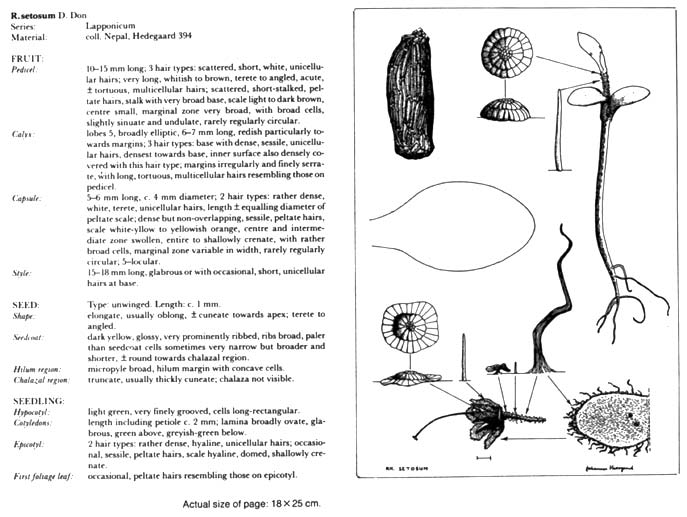BOOK REVIEW
Fred Galle, Pine Mountain, GA.
Studies In The Genus Rhododendrons, 1980
Johannes Hedegaard, G. E. C.
Gads Publishing House
32 Vimmelskaftet 1161 Copenhagen, Denmark
Dr. Hedegaard presented a paper on his work the Morphological Studies of Rhododendron Fruit, Seeds and Seedlings at the International Rhododendron Conference in 1978. I was extremely interested in his work for Dr. Hedegaard is not only a dedicated scientist, but also an artist and sculpture.
The two volume study contains drawings and descriptions of capsules, seed and seedlings of 300 Rhododendron species. The detailed line drawings were made using a microscope with up to x 100 magnification.

|
Often our literature and keys, referred to plants with or without hairs, but never considering the five major categories is included in this study. Likewise with seed. I know the seed of rhododendrons could be winged, tailed, and without wings, but never visualizing the variations in the winged appendages as described and represented in the detailed line drawings. The introduction from the book by Dr. Hedegaard is an excellent review.
In more recent years, studies of the hair-covering of
Rhododendron
leaves have demonstrated the usefulness of this feature as a taxonomic criterion. Information on leaf hairs, considered together with the more normal morphological characteristics of species has played an important part in the continuing revision of the genus
Rhododendron
with its c. 900 species.
However, the morphology of
Rhododendron
fruits, seeds and seedlings have received relatively little attention in this context. With the exception of the separation of the section Vireya (Sleumer), these features have only been studied in detail for a very few species.
The idea of initiating the present studies grew from the uncertainty encountered in attempts to identify species of
Rhododendron
using existing keys and descriptions; either the morphological tolerance seemed to be too narrow, or descriptions in which hairs were considered, simply referred to leaves and other organs as possessing hairs. When attempting to identify plants it soon became evident that the designation "possessing hairs" was too vague and that much time could be saved and uncertainty avoided if descriptions included more detailed information on the hairs associated with each species.
Differences between species in the shape of seeds, as observed under the microscope whilst cleaning seeds prior to sowing, also appeared to be promising from a taxonomic viewpoint.
Seedlings also fall naturally within the scope of the present investigations, along the same lines as the plant parts mentioned above.
After a relatively short period of time studying these aspects, it was decided to undertake an extensive survey of the fruit and its hair-covering together with the morphology of seeds and seedlings and in this way establish a sound foundation for the more accurate description of species. As already mentioned, the morphology of these plant part is more or less constant for a particular species and often gives the clearest indication of hybridization.
Leaves and fruits are present on
Rhododendron
plants for most of the year, while flower characters, the main criteria in contemporary classification, can only be observed for a relatively short period of time.
It is hoped that these studies will help elucidate those problems which must be solved before a more critical, authoritative treatment of the
Rhododendron
genus can be made; also the described characters may be used to supplement those already used in keys and thus facilitate more critical determinations.
The summary includes a tabular survey of hairiation in fruits and seedlings. There is also a pictorial comparison of seeds of 18 species in the Luteum subseries. While the II volume study may not be for every rhododendron grower, it is important to know that such a detailed study exist.
The rhododendron taxonomist will find the detailed drawings and descriptions very important and hopefully it will be found in all major libraries.